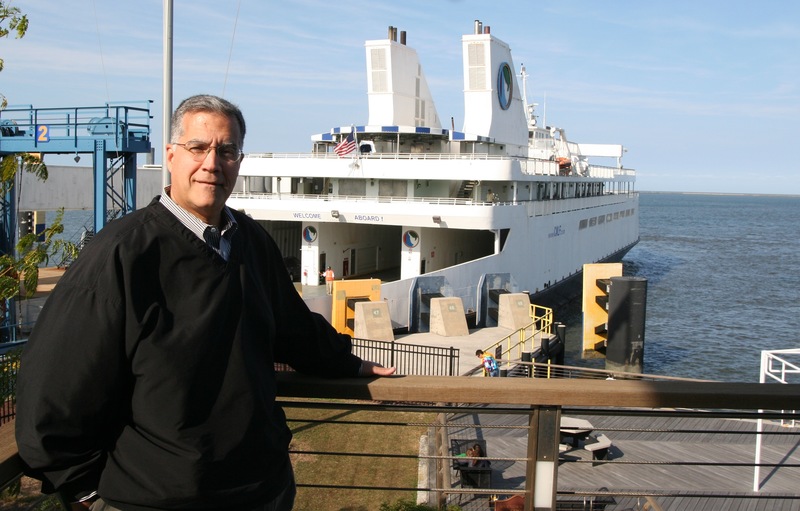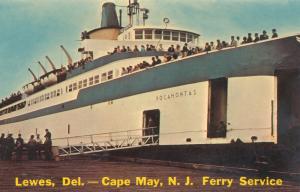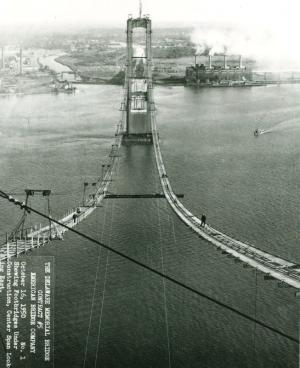Delaware River and Bay Authority celebrates 50 years

The Delaware River and Bay Authority is one of the nation’s most unique organizations. The authority’s purpose: advance economic development in Delaware and New Jersey by facilitating transportation links.
Many have had the pleasure of crossing Delaware Bay aboard a ferry, the convenience of driving across a bridge spanning the Delaware River and realized the importance of air terminals in Delaware and southern New Jersey.
These amenities exist in Delaware and New Jersey because of the Delaware River and Bay Authority.
U.S. Congress created the authority, DRBA, on Sept. 20, 1962, upon signing of a Delaware-New Jersey compact.
Congress saw a need for closer cooperation between the states because of trends in– increased traffic, growing population and burgeoning industrialization.
The Delaware River created a natural obstacle between the states, Congress observed, and the compact made bridging the divide possible.
The cooperative agreement created regulations for financing, constructing, operating and maintaining vital transportation links to drive future economic development.
Today, the DRBA owns and operates Delaware Memorial Bridge, Cape May-Lewes Ferry, Three Forts Ferry Crossing, New Castle Airport and four other airport facilities; and Salem Business Centre in Carney’s Point Township, N.J.
“There’s a magic to the kind of things the DRBA does. Bridges are massive, interesting and inspiring from an engineering standpoint. Airports are where parents take their kids when they’re young to watch airplanes takeoff,” said Scott A. Green, the agency’s executive director.
Appointed in 2009 to serve as a DRBA commissioner, last spring Green became only the fourth man to hold the executive director’s position. Green is responsible for managing the authority’s transportation operations and for economic development initiatives permitted by the compact. The job keeps Green on the move, and the authority keeps the green coming in.
“The total revenue for the bridge, ferry and airports is about $120 million a year. More than 80 percent of that comes from the bridge.
“It would be unfair to say that we’re completely bridge-centric, but we do spend an incredible amount of time and energy to make sure that the bridge is maintained,” Green said.
He said ferry operating expenses exceed revenue, and bridge and ferry revenue tend to follow the economy.
“In my mind the bridge and ferry operate as a unified transportation system; it happens that the bridge makes money, and the ferry is an expense,” Green said.
Cape May-Lewes Ferry: Ever improving
In 1962, the DRBA rented the Pocahontas, a ferry owned by the Virginia Ferry Co., to determine if it was feasible to operate scheduled ferry service between Cape May and Lewes.
The event was momentous; schools in Cape May County closed for the afternoon so students could greet the vessel after its then-90-minute crossing.
Green said the ferry’s test run was an inauspicious beginning: the Pocahontas ran onto a sandbar where it remained trapped for nine hours.
“In some ways it defines the beginning of our ferry system because we operate a deep-water, ocean-going ferry. There are a couple shallow places in the bay, and you have to have a boat that’s capable of crossing very shallow areas,” he said.
About once a week, Green said somebody comes up and tells him a crazy story about something from the ferry’s early days.
He said judging from the number of people who have told him they were aboard the Pocahontas the day it ran aground, there must have been 500,000 passengers on the vessel.
“Everybody says, ‘I was on it when it got stuck. There are people around who were on it – as little kids,” Green said.
During the ferry’s early years, Green said, it was a time-saver for passengers who drove aboard.
“It was a wonderful, new thing, and that drew a lot of people. It had a real tactical advantage, and it kept getting people. But with the opening of Route 1 that tactical advantage was minimized,” he said.
As times changed, so too have ferry service, management and marketing strategies.
“It has to be much more customer focused, and using the ferry has to be much more of an event in itself. Between now and 2014, you’re going to see a real shift in focus at the ferry.
Green said the ferry has been dismissed by people in Cape May and Lewes as just another form of public transportation. “The past couple summers we’ve been focused on making the terminals themselves a destination,” Green said.
He said during the off-season the vessels and terminals could serve as the perfect town square.
“I’ve heard people say our terminals are like bus stations for boats; that’s not what I want them to be. I want them to be gateways into the two communities.
“I’d love to see a place that has a thriving restaurant even in the off-season. I don’t want to compete with great institutions like the farmers markets in Lewes and Rehoboth; I want to complement them,” Green said.
This year, for the first time, the ferry partnered with AAA offering reduced rates for members who walk on.
“You can’t just open up the doors and expect people to show up. We have to operate it carefully– make it fun,” Green said. He said social media, word of mouth and a marketing plan using the catch phrase ‘Take a break from the ordinary’ have become effective promotional tools.
The restaurant on the Lewes side has become a real local’s hangout, mostly because of social media, Green said, referring to On the Rocks, which offers light fare, adult beverages and a bayfront setting.
Fun and ferry improvements ahead
Several events are lined up throughout 2014 to celebrate the ferry’s 50th anniversary.
In the summer, WHYY-TV will air a documentary about the Cape May-Lewes Ferry, and both terminals will feature displays and special events. Special events are planned aboard the boats.
“We’re looking forward to making it a pretty big summer,” Green said.
Several vessel improvements are already under way, and both terminals will soon have new loader tubes, the moveable ramp used by foot passengers to board the ferry.
“Our tubes work so that you can walk safely onto the vessel. But they’re old, they’re clunky, and they weren’t designed to operate in a marine environment,” Green said.
He said new tubes for each terminal are being custom manufactured. In the Lewes terminal, the new tube is scheduled to be installed this winter.
The vessels are also undergoing extensive interior work for passenger safety and comfort.
Renovation of the MV Cape May is completed and the ferry is back in service.
Interior work started this month on the MV New Jersey, MV Delaware and MV Cape Henlopen.
New flooring is being installed along with theater-style seating, with some recliners.
“It’s a totally different look. The old salons in the boats were fun in a way because they were open and you had tables and you could sit in groups. But if you were by yourself sitting at a table, you took up four seats,” Green said.
He said during summer’s peak ferry use, finding a seat has become increasingly difficult, and the new interiors have added seating in various styles.
Interior work takes about three weeks per vessel to complete and ferry employees are doing the work at the Cape May terminal.
“I hope when people see it they’ll find it really beneficial,” Green said. He said the ferry has more regular commuters between Lewes and Cape May than many people realize.
“There are a lot of business people who go back and forth, and a lot of families that are split between the capes. It’s an interesting sea-going community,” he said.
Since the start of service on July 1, 1964, more than 34 million passengers and 11 million vehicles have made the 17-mile trip across Delaware Bay aboard Cape May-Lewes Ferry vessels.
Each ferry accommodates up to 1,000 passengers and up to 100 vehicles. The mini-cruise bay crossing takes 80 minutes.
“I really do think we can make the ferry system healthy and sustainable. Maybe not to the point where we ever get it to pay for itself,” Green said.
Delaware Memorial Bridge: Major link, moneymaker
Green said the Delaware Memorial Bridge generates about 80 percent of the authority’s revenue.
The first span opened in 1951, and by 1955 nearly 8 million vehicles a year were crossing the bridge, almost double the original projection. A second span was constructed; it opened in 1968.
When the new span opened, the old span closed for a year for extensive maintenance.
Green said bridge traffic is projected to increase 1 percent to 2 percent a year on a relatively steady basis for the next several years.
He said motorists who cross the bridge going 50 miles per hour don’t typically look up. But if they did, he said, they’d see workers clipped to the structure inspecting or maintaining it.
“Very few members of the public get to get into the elevator and go down to the base of the bridge or go up to the top of the towers. It’s an amazing piece of engineering, and to me, it’s an inspiring piece of public works,” Green said.
He said there have been several extensive studies looking at the feasibility of a bridge or tunnel linking southern Delaware and southern New Jersey.
“I don’t think it’s viable because the communities that we live in on both sides have outstanding north- south road networks, and horrifyingly poor east-west road networks,” Green said.
Those studies indicate, Green said, that if there were a bridge, it would be located significantly north of Lewes and possibly north of Sussex County.
“The closer you get to the memorial bridge, you wonder why spend all that money,” he said.
In his wildest dream, Green said, there’s one thing he’d like to see added to the bridge.
“The Golden Gate Bridge has a separate structure attached to it for pedestrians and bicyclists. I’d like to have such a facility on the Delaware Memorial Bridge. It would be an amenity for people in both states to get out, on, and over that river,” he said.
More than 86,000 vehicles per day cross the twin spans.
On Dec. 18, the one-billionth vehicle crossed the structure: Gov. Jack Markell and Delaware River and Bay Authority commissioners greeted and congratulated the driver, Jeff Wright, a 51-year-old computer consultant from Wildwood, N.J., who was headed to Wilmington to meet a customer.
Markell presented Wright with a framed commemorative photo of the Delaware Memorial Bridge, a copy of Bill Miller’s “Crossing the Delaware,” a book chronicling the history of the bridge, and a souvenir silver bridge token.
The authority will also load $250 onto Wright’s E-Z Pass account. The bridge toll is $4.
The Delaware Memorial Bridge is a lasting memorial to those soldiers who gave their lives in World War II, the Korean War, Vietnam War and Operation Desert Storm.
Each Veterans Day, a ceremony is held at the Bridge War Memorial, overlooking the twin span.
Airport operations: Future economic potential
Green calls the authority’s airports “The last piece.” He said, “That’s where the most economic development potential exists.”
In 1995, the authority assumed previous-owner New Castle County’s airport debt obligations, capital costs, equipment and associated expenses totaling $7 million.
In 2002 the DRBA made its final debt obligation payment. The authority has a 30-year lease on the airport with an option to automatically renew for up to two additional 30-year periods that would run through 2085.
Since taking over operations, the authority has made the airport profitable. Several old buildings have been upgraded, and numerous new buildings and facilities have been constructed.
The airport is certified Class 1 by the FAA; it serves all types of scheduled operations for air carriers using aircraft designed for at least 31 passengers.
At one authority airport Boeing converts Chinook helicopters for desert service.
“Because we operate as an aviation system, we’re in contact with players like Boeing,” Green said. He said when Boeing needs to move a helicopter from its plant in Ridley, Pa., for additional work, it’s flown to New Castle Airport.
“We competed with an operation down in Mississippi, and we were successful in getting them– partly because we had a facility that was built, ready and the size Boeing needed,” Green said.
At the New Castle facility, Dassault Falcon Jet Corp. designs, manufactures, sells and services business jets.
“Dassault is a major employer in the area. They have about 400 people. Del Tech runs the program in Georgetown to train avionic technicians,” Green said.
Other aviation customers include Aero Taxi Inc. and Aeroways Inc., which offers jet aircraft maintenance, charter and management services; Atlantic Aviation, based in Plano, Texas, offering general aviation services; and Flight Safety International, which provides simulator and classroom flight training for Boeing pilots and other corporate flight departments worldwide.
Green said Air Force One has used New Castle Airport for training purposes for several years. “Every time it comes in we get dozens of calls from the neighbors about noise, even though it’s been going on for decades,” he said.
Delaware State University’s aviation program is based at Delaware Airpark in Cheswold. “It’s a great program. Kids go to school and come out with great jobs, some at the DRBA,” Green said.
Delaware State University’s sports teams use the authority’s Civil Air Terminal in Dover for its charter flights; and NASCAR’s jet-set uses the facility when racing at Dover International Speedway’s Monster Mile.
None of DRBA’s airports offers scheduled passenger service, although it has been tried and carriers are still interested in doing it, Green said.
As a small airport example, he said Manchester Airport is an hour from Boston; it carries the designation Manchester/Boston.
“I don’t think it’s far-fetched at all to think that at some point an airline will want to have Wilmington/Philadelphia listed. Those of us who use Philadelphia know that from time to time it’s a mess,” Green said.
But, he said, the authority isn’t actively pursuing passenger airline carriers.
“For economic development at the airports, we will aggressively pursue the kinds of businesses and facilities that we have today. They tend to come where the job market is and where the employment base is, and we can help those companies,” Green said.
He said at some point, growth south of Wilmington will make driving to Philadelphia increasingly inconvenient and the market will demand easier access to an airport.
Even though Sussex County might not experience direct benefits from the authority’s airports, Green said benefits do exist.
“If there’s a company at New Castle Airport that has 400 employees and we can help them expand to 600 jobs, some of those people are coming from Sussex County. The airports have huge economic development potential,” Green said.





























































